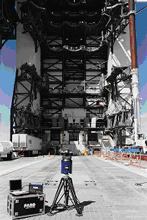FARO Plays Vital Role in Boeing Delta IV Launch

Lake Mary, Fla. – March 18, 2003 – The FARO Laser Tracker, built by FARO Technologies, Inc., played a key role in The Boeing Company's Delta IV rocket launch, on Mar. 10 that successfully deployed into space the first satellite for the United States Air Force's Evolved Expendable Launch Vehicle program. The Laser Tracker helped with measuring tasks that were critical to building and testing the launch pad's Fixed Pad Erector (FPE) system at Space Launch Complex 37B, Cape Canaveral Air Force Station, Fla.
"Our Laser Tracker has gained widespread use in large-scale dimensional measurement applications that demand portability, accuracy and speed," said Simon Raab, President & CEO of FARO. "It complements and sometimes supplants other commonly used portable coordinate measuring machines [CMMs]."
The 164-ft. long FPE raises the rocket vertically, aligns it, and transfers it onto the launch table. It works somewhat like a drawbridge, with more than two-dozen precision interfaces requiring tolerances of +/- 0.030 in. (762 microns). The FARO Laser Tracker is accurate to within 10 microns + 0.8 microns/meter and works at a range up to up to 230 feet.
During construction of the FPE, the Tracker was set up on the launch pad to measure and locate the interfaces. It projected a beam that locked onto a handheld retroreflective target, which is moved by the operator over the surface being measured. The beam reflected off the target and retraced its path back to the Tracker to measure distance. Angular encoders measure the orientation of the Tracker's two mechanical axes. Together the distance and angular measurements provided the exact three-dimensional location of the target. Measurement data, as well as 3D graphics created from the data, are displayed on a PC or laptop connected to the Tracker.
Key to its ability to perform on the launch pad was an integrated weather station that monitored temperature, air pressure, and humidity at the beam. FEA of all kinematic and athermal components ensured the stability of the Tracker itself in variable conditions and over time, as does the thermally stable aluminum alloy used for structural components.
FARO Technologies Inc.
